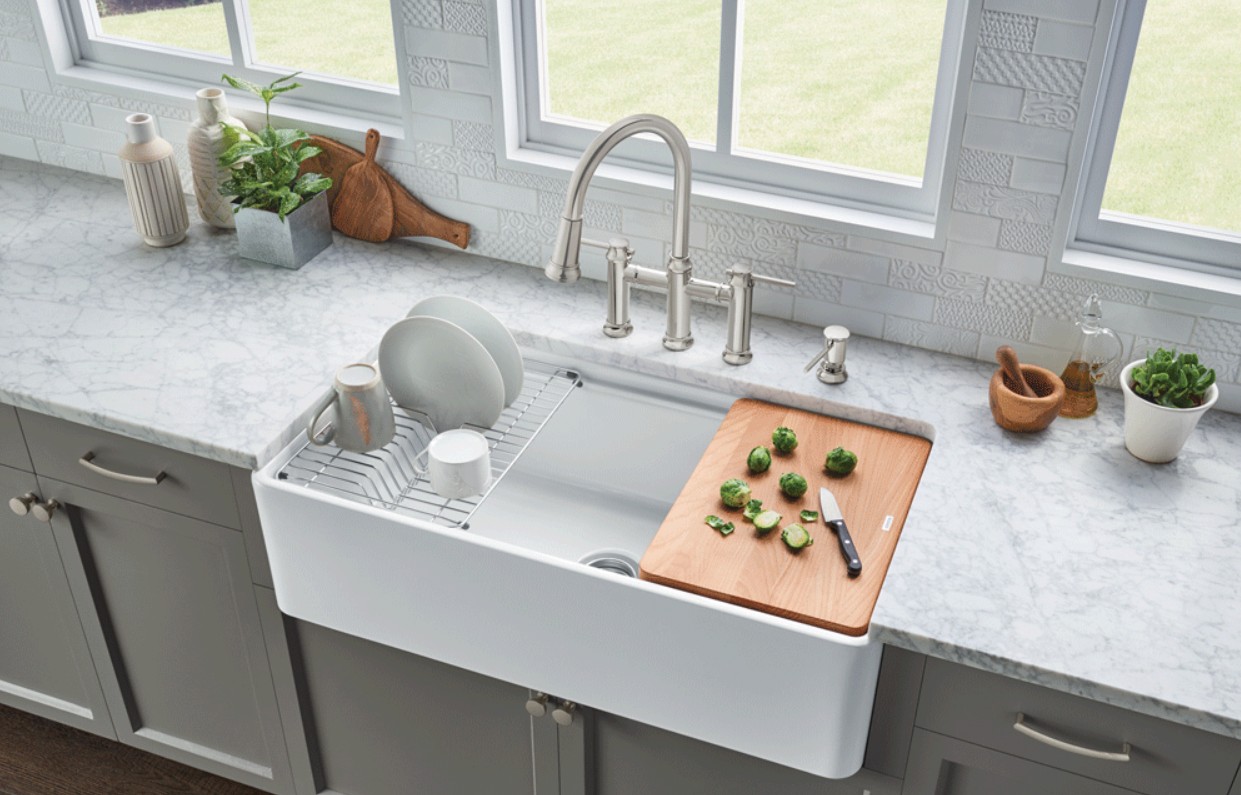How To Replace A Kitchen Faucet?
Table of Contents
How to choose a kitchen faucets is not as easy as it looks. You need to consider a lot of factors, which includes the spout height, the handle’s turn range, turning radius, the water’s flow ability, the mounting surface and many other factors. You need to ensure that the faucets extend far enough to accommodate all round the sink’s countertop. You can’t have one turned out too low and end up with a spilling water all over the floor. You don’t want this to happen if you are trying to organize the clutter in your bathroom.
The next thing to do after you’ve determined the right replacement kitchen faucets for your sinks is to find the exact old faucets that you need to match the holes on your sink. If you are replacing an old faucet with a new one, then you need to find the same number of holes. Most likely, the instructions included with your old faucet will also tell you how many holes you should be locating on the sink itself. To do this, you need to first locate the drain hole in your sink using a tape measure or a straight line drawn across the drain.

How long can I expect my kitchen faucet to last?
How long can I expect my kitchen faucet to last? This is one question many ask who own a faucet that has seen better days. Faucets have come a long way in both style and quality over the years, but there are some parts of the faucet that can easily wear out after several years of use. If you want to keep your kitchen faucet going for a few more years, here are some tips on how to take care of it.
The first thing to do is to find a faucet handle that matches the style of the faucet. For example, if your faucet is an antique, you may want to look into brass handles. Brass has a nice, golden shine to it, and is often used in high-end faucets because of its durability. Unfortunately, it can also rust after much use, making it susceptible to corrosion and tarnishing. A brass faucet handle is much less likely to corrode, and will last much longer.
While you’re looking for a new kitchen faucet handle, you may also want to consider changing the faucet head. You can get a faucet head in any style that will match the faucet handle, including classic or modern designs. If you have a lot of brass faucets in your kitchen, you can get a matching brass or copper faucet handle to match. Many faucet companies offer matching head options, so you should be able to find something if you take a little time looking.
Many kitchen faucets now come with soap dishes that will need to be cleaned regularly. For this reason, it’s important to make sure that you get a faucet with a dishwasher feature. This will allow you to simply hand wash your dishes instead of using a dishwasher. Some faucet manufacturers still produce faucets without this feature, but you will often pay extra for this.
How about the water pressure? All faucets are designed to give the same amount of water pressure. If you experience any problems with the water pressure at your home’s main water supply, it’s likely that it’s the sink holding the water back. This problem will only affect you if you’ve recently washed any large items in the sink, such as pots and pans. It’s the same problem as it applies to under-the-sink plumbing. You’ll usually have to replace the sink, and possibly the faucet, in order to fix the problem.
Another factor that affects the life expectancy of a faucet is how it’s kept clean. This involves cleaning it every six months or so, depending on how frequently you use the faucet. A lot of older faucets use washers that contain abrasive material, which can wear out over time. If you don’t clean your faucets on a regular basis, you may not be able to keep them running properly.
How long will my kitchen faucet last? A faucet’s lifespan depends a lot on how it’s used. While you shouldn’t worry too much about how long your kitchen faucet will last, you should also be aware of what types of materials it is made of. Plastic kitchen faucets are typically only recommended for single-use. The best choice would be a brass or copper faucet, which are much longer lasting, but are also more expensive.
How long will my kitchen faucet last? Knowing the answers to this question will give you the peace of mind to properly care for your faucet, and to also have it ready when you need it. It will also make it easier to find replacement parts should your faucet ever break or need repair work done.
How to Deal With a Leaky Kitchen Faucet?
How to deal with a leaky kitchen faucet? That is a question I get asked a lot. In fact, this very question has been the subject of my blog for some time. This article will deal strictly with that problem. In short, you can prevent your kitchen faucet from getting plugged if you have the right tools.
If you’ve noticed that your sink, tub or shower doesn’t feel quite as warm as it once did, it may be the result of water leakage. That leakage can occur in any faucet, even if it is not plugged. The issue is usually a lack of proper water flow. Water that is too hot or too cold can damage the tubing and the faucet, causing both leaks and damage. So, what causes these leaks?
Older, less efficient hoses and faucets used water that were colder than the water temperature that was flowing through them. As a result, pressure drops as water flows through them. When the water temperature drops, so does the pressure drop. Over time, this can cause a build up of pressure in the system, resulting in leaks. You need to repair or replace the old hoses and faucets to prevent leaks. If you notice a constant leak while washing dishes, it is more likely that they are the result of a low water pressure valve.
A kitchen hose is the mechanism that brings water into a home. It goes through many different components, many of which are not made to withstand extreme heat or cold. Even if they do, there are typically parts that wear out. As time passes, the seals between the pieces of hardware or the joints between the segments of the hose begin to deteriorate. This results in water leaking from the faucet, which can cause major damage to your kitchen. To keep your kitchen safe, make sure that you regularly inspect the hose for signs of wear and tear.
Leaky kitchen faucets often result from a valve becoming plugged. This is the most common reason why kitchen pipes begin to leak. If your kitchen faucet begins to drip or leak when you least expect it, have it serviced by a plumber right away to be sure that nothing is drastically wrong. The sooner that a problem is dealt with, the less likely it is that you will have to deal with serious damage to your kitchenware.
Another reason why valves develop leaks is because of a lack of cleaning. If you use hot water and clean it using soap, the soap can leave behind residue that causes the valve to become plugged. Over time, this leaves the valve open so that the water can seep through. If the leak is not immediately noticed, you could very well be opening the door for water to flow in, causing damage to your kitchen.
How to deal with a leaky faucet can also include adding more water to the tub to try to solve the problem. Although this can work, it can easily worsen a leak. Be sure to add enough water so that the leak doesn’t continue and also make sure that the area around the spout is cleaned to prevent future problems.
When learning how to deal with a leaky kitchen faucet? There are a number of different remedies that you can try, ranging from simply rinsing the sink and counter with antibacterial liquid to actually hiring a professional plumber to resolve the issue for you. You’ll probably want to first try one or more of these simple home solutions until you are able to address the real issues behind the leaks.
How To Replace A Kitchen Faucet
Are you thinking of replacing your kitchen faucets? Have you ever wondered how to do it? If your old faucet still in fine condition, you could replace it for less than $40. There are lots of good replacement parts available at the local hardware store. But beware: It is not that easy to get exact fits!
First things first, you need to get a basin wrench set. The best brand is Norelco. This is because it has all the different fittings and sockets you will need to replace your kitchen faucets. It comes with an assortment of nuts and bolts, and also a washer and a nut assembly. It also comes with a washer and a nut assembly for mounting the sink and spout, as well as a wrench for removing the drain handle.
Next, go to your local home improvement store and purchase a hose-and-rim kit. These kits come with a hosing strip and a matching sponge, as well as a matching nut and bolt kit. These too come with plenty of nuts and bolts and a washer and a nut assembly for mounting the sink and spout.
Once you have everything gathered up, your next step is to take your kitchen faucets hose and put it in reverse, as far as the size of the hole is concerned. Start with the end of the hose and work it down to the sink. Put a few of the washers and bolts on the side of the hose. This will help keep the hose secure while you are working on your faucet installation.
Now that you have your hose and all the other parts in place, you are ready to replace your kitchen faucets. You can either replace the entire thing, or just replace the sprayer. If you want to replace the entire thing, start by removing the gasket from the spout and putting that aside. Take out your old sprayer and put that aside as well.
The next step on how to replace a kitchen faucet, is to start replacing the screws that secure the spout in place with the washers and the bolts. Once you have these replaced, pull out your old spout and attach the new sprayer to the spout. If you are replacing an old fixture, simply screw the washers and bolts together, but if it is a brand new fixture, you need to attach it to the kitchen wall. Now it’s time to install the new faucet!
When installing a new kitchen faucet, always make sure that it goes on only one way. Otherwise, you might be able to pull it off if you accidentally turn it in the opposite direction. Then start to thread the new faucet through the sink and attached to the wall securely. Once it is completely installed, remove the old kitchen faucet and replace the new one with the same type of handle.
For adjustable wrench instructions on how to replace a kitchen faucet, look at the instructions under the sink or in the manual that came with it. For example, if you are using a standard adjustable wrench, you would read “to remove” and then “to set” before you would read “how to replace a kitchen faucet with an adjustable wrench.” On the other hand, if you have a counter-top mounted sink, then you would read “how to replace a kitchen faucet with an adjustable wrench.” Either way, most kitchen faucets have the adjust-rod located under the waterline, so all you need to know is where to find it.
If you have both a garbage disposer and a kitchen sink, then you know how difficult it is to install the garbage disposer without first uninstalling the kitchen sink first. However, if you have the pipes connected, then it is usually a simple matter of attaching the drain lines from the garbage disposal unit into the kitchen sink and then attaching the kitchen sink to the drain lines. Again, the instructions should tell you how to do this. Then you will need to know how to turn the water on and off, as well as know how to unhook it from the drain lines.
The last step is pretty simple: unscrew the nut that connects the bowl to the stem of the faucet, and then pull the plug out. This is also the same photo 4, but the bowl is now at the bottom of the sink. Once the nuts are removed, you can slide the bowl out and attach it to the sink. Once all of the nuts are removed, you can attach the faucet stem to the bowl with the bolts and washers, and screw the nut back into place. You can then replace the gasket, attach the new one, and your job is done!
You don’t have to be an expert to do this, but you will need to have some basic tools. The most important tools are a basin wrench and pliers. Other than those two tools, you may want to use some other tools like a tape measure, some thinset and/or bendable wire, a small socket, and an adjustable wrench. Once you have the tools you need, you can begin to replace the old water lines and faucets, and installing the new ones.
How To Repair A Leaking Kitchen Faucet
While every homeowner knows that a clogged or blocked kitchen faucet is a sure recipe for disaster, the same is not always true with a leaking faucet. When a faucet gets plugged, it can be tempting to fix the problem yourself, but doing so without expert help could end up costing you more money in the long run than the initial expense of buying a new kitchen faucet. Here are some tips on how to repair a leaking kitchen faucet.
Before you can attempt to repair the problem, you first need to determine why the faucet is leaking. The most common causes of a leaking faucet are holes or cracks around the spout, which allows some water to escape before the faucet is completely shut off. Other times, the problem may be as simple as a drainage hole near the bottom of the faucet. In either case, you need to find and repair the problem quickly to avoid water damage to your home and personal belongings.
Once you have determined the source of the leak, the next step is to test the faucet to determine if it is actually leaking. To do this, turn off the water supply by closing off the shut-off valve. Now, using a flashlight, shine it toward the spout and see if you see any condensation forming. If so, you likely have a leaking faucet. On the other hand, if no condensation is present, you likely have a non-leaking faucet.
While you are testing the faucet, also try to locate the exact make and model number of the parts that may be damaged. It’s also helpful if you can remember the exact date that the leak occurred. In order to complete the repair job properly, it’s important to refer to the owners manual that came with the faucet.
Next, you’ll need to unscrew the nut securing the water pipe to the sink. Once the nut is loosened, you can remove the water pipe from the sink. You’ll also want to remove the washer and screw holding down the drain plug. This allows you to remove the gasket from around the spout, which will allow you to replace the gasket. Put the new gasket on and reattach the sink to the cabinet.
Now that you’ve replaced the gasket, you should install the new spout and bolt the sink back into place. The washer and screw are kept together by a washer, so these tools will have to be carefully used to install the spout. If problems arise, it’s best to use pliers to help prevent them from spreading to other parts of the faucet. This will save you from more damage to your faucets.
The last step in learning how to fix a leaking kitchen faucet is to fill the sink with water and soap. Wipe the area surrounding the leak to make sure nothing is left behind. If necessary, add more soap and water until the stain is gone. The soap and water solution is great for cleaning the area, but it will also be helpful in removing any excess water that may have gotten through the faucet.
If none of these solutions works for you, or you can’t find the replacement part, consider calling a professional kitchen installer. While it’s true that most home repairs can be done yourself, many people don’t have access to the right tools or expertise when it comes to repairing their sinks and faucets. A contractor can save you time and money by doing the job right the first time and taking less time than you would if you tried to tackle the task yourself. Learning how to repair a leaking kitchen faucet is really no different than learning how to do many other small tasks, so before you begin your next kitchen remodeling project, take the time to learn how to replace, install, or repair a faucet!
How do I remove the aerator from my faucet?
How do I remove the aerator from my kitchen faucet? Have you ever thought about installing one? They are relatively inexpensive and make any kitchen more beautiful. However, there are few things that people should know before going out to buy one. The aerator comes with an O-ring. This o-ring seals the aerator to the faucet.
If you want to replace the aerator on a kitchen faucet, then you have to take out the old one first. This is also referred to as “removing the spout”. Then, you need to attach a new aerator in its place. In most cases, this involves placing a piece of copper tubing inside the spout. Make sure to secure it tightly.
How do I keep it in place? To prevent water from seeping out, you need to seal the spout with a copper or brass plate. Alternatively, you can use packing tape. Just make sure that the edges are squared. You can experiment with different materials and methods to solve this problem.
How do I remove the aerator from my kitchen faucet? One way is to install a splitter to prevent unwanted water from going out. The splitter has a secondary outlet that allows water from the main line to pass through.
What does this method do to eliminate the aerator from my kitchen faucet? It forces the excess water to go down by the spigot, thus preventing it from splashing into other areas. It also stops the water from getting stagnant around your sink. Some people claim that it works as well as a shower head filter. There are disadvantages to this method, however.
How do I remove the aerator from my bathroom faucet? Your bathroom faucets usually don’t have an aerator. Instead, they have what is known as an indirect water supply. This means that it is delivered through a hose to the wall water supply, and the water that comes out has no chance of going anywhere.
This will work if you’re only taking warm showers or doing laundry. When it gets really hot outside, the direct water supply can get clogged. When this happens, the flow gets cut off. This can lead to a slower water flow, or even a shut off on the plumbing system.
How do I remove the aerator from my kitchen faucet, then? To remove the aerator from a kitchen faucet, you first need to turn off the water in the faucet. Then, remove the aerator with either a wrench or a screwdriver. The aerator should stick out, and you will probably need some plumber’s putty to seal the gap between it and the faucet body.
How do I remove the aerator from my bathroom faucet, then? To remove the aerator from your bathroom faucet, you first need to turn the water off. Then, take off the handle on the aerator. Place it on the floor or something that will securely hold it in place, and then use plumber’s putty to seal the gap between it and the faucet body. You may need to use some oil to keep it stuck in place.
How do I remove the aerator from my kitchen faucet, then? To remove the aerator from your kitchen faucet, you first need to turn the water off. Next, remove the handle from the faucet. If you have any stoppers, unscrew them. You can use a screwdriver or pliers to do this.
How do I remove the aerator from my bathroom faucet, then? Again, turn off the water. Take off the handle and the aerator itself. Use pliers or a screwdriver to do this. The last step is to seal the gap between the aerator and your wall or plumbing fixture by using silicon caulk or filler. This will keep it in place and ensure water flow through it.
It sounds pretty simple, doesn’t it? With a bit of reading material and a bit of trial and error, you should be able to remove your aerator with minimal fuss. Good luck, and may all your mermaids be happy!
Conclusion
Now, with everything aligned, pull off both ends of the threaded ends of the old faucets until you reach the center section of the threaded part. You have to make sure you find the screw connection, which will be located at the bottom of the hole. Use a screwdriver to turn and remove the screw from its socket and then turn it clockwise to loosen the screw. Then, you need to unscrew the washer that connects the new faucets to the rest of the threaded connections. Once that is done, you just have to reassemble all the parts and you are good to go. However, if you want the easiest possible replacement of your kitchen faucets, then you can go for the models that already have all the connections enclosed in one long body.


